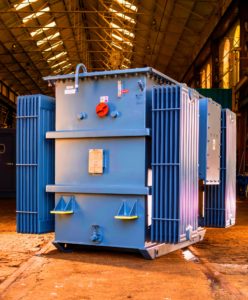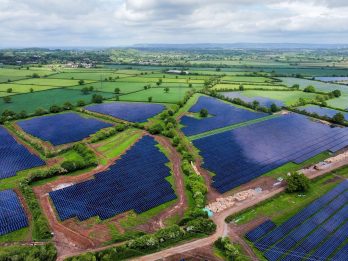What should come first solar PV or replacing transformers?
Comparing solar Photovoltaic systems to distribution transformers is not exactly straightforward, the former is used for generating electricity and the latter for transmitting and distributing it. Does that make it a case of apples and oranges comparison then? Not quite. Eng. Ayah Alfawaris elaborates below. 
The shift to renewable energy surged exponentially after the prices per kWh have come down. Governments and big corporations realised that diversifying the energy mix and including renewable generation is not only good for the environment but also for energy security.
In the past 12 months, almost half of the electricity generated in the UK was low carbon. 4% of which was generated by solar PV, making it the seventh biggest electricity source in the country. The government has invested a lot in solar PV, from funds and incentives to legislations that allow users to export electricity to the grid through feed-in tariff previously and smart export guarantee now.
Transformers, on the other hand, have not received any support from the government. No one wants to talk about grey boxes that get installed and forgotten for decades regardless of how much energy they waste or carbon emissions they emit. We realise they are not as attractive as other emerging technologies, but they offer a huge potential for energy savings that have been overlooked for years.
We argue that comparing apples to oranges is doable, taking into consideration calories, weight, price and nutritious value. Similarly, comparing solar PV to transformers is valid taking in mind the Net Zero targets and the very little we can do with the allocated resources and the technical limitations. Everyone knows that as a rule of thumb in energy, efficiency comes before generation just like reducing comes before recycling in the 3Rs. After all, what is the use of generating green electricity if it is going to waste?
Why Transformers?
The main function of distribution transformers is to convert the electrical current from one voltage to another. Transformers waste energy as a by-product of their operation. The wasted energy happens in two forms; load losses and no-load (core) losses.
Transformers are responsible for 25% of the UK’s network losses. The EU estimates that 2.9% of all electricity generated across the continent get wasted through transformer losses, according to 2008 across the EU27. That amounts to 93.4TWh which is enough to power Denmark for 3 years.
When the conversation about energy efficiency takes place, people immediately start thinking of ways to save energy inside the building (lighting, double glazed windows, inverter air conditioning, etc.) but very little think of transformers. Transformer losses, despite being undesirable, they are unavoidable. But we at Wilson Power Solutions spotted a great energy efficiency opportunity in reducing these losses.
Amorphous Technology
Core losses occur 24/7 from the moment of energising the machine, the only thing we could do about it is changing the core metal material from Cold Rolled Grain Oriented (CRGO) steel to amorphous metal.
The cores of conventional transformers consist of stacks of laminations that are made from silicon steel with an almost uniform crystalline structure (CRGO). In transformers with amorphous cores, a ribbon of steel is wound to form the core. The big benefit of amorphous transformers is that amorphous steel has lower hysteresis losses. Simply put, this means that less energy is wasted as heat during the magnetisation and de-magnetisation of the core.
Amorphous metals are made of alloys that have no atomic order. They are made by the rapid cooling of molten metals that prevents crystallisation and leaves a vitrified structure in the form of thin strips. Due to the lack of systematic structure, this type of metal has also been given the name “The Metallic Glasses”.
Eco Design Directives
The European Commission issued regulation No 548/2014 on implementing Directive 2009/125/EC regarding small, medium and large power transformers. The regulations are referred to as Eco Design Directives for Transformer Losses Tier 1 and Tier 2. Tier 1 was effective as of the 1st of July 2015 and Tier 2 will come into force on the 1st of July 2021 (almost two years from now).
Tier 1 and Tier 2 regulate transformer losses by forcing most new built transformers to have improved (less) losses. At Wilson Power Solutions, we believe these targets could be pushed even more. We launched two amorphous metal core products to exceed Eco Design losses, Wilson e2 super low loss transformers and Wilson e3 ultra low loss transformers.
Europe’s Most Efficient Transformer
Wilson e3 Ultra Low Loss transformers are believed to be Europe’s most efficient transformer. We pushed the losses low to create a great case for energy savings and carbon reduction. Installing an Ultra Low Loss transformer instead of Tier 1 complaint transformer could save organisations over 18,000 kWh of electricity and 5.2 tons of CO2 emissions per annum. This is not just a great energy efficiency potential, but it adds £75,000 to the bottom line.
Both the super and Ultra low loss transformers, (Wilson e2 and e3), have proven to provide superior operational efficiency when working alongside in-built voltage management capabilities, achieving savings both financially and environmentally.
This has attracted large organisations from varying sectors especially after the technology won the prestigious IEMA Sustainability Impact Award for having over a thousand installations across the UK and helping many organisations meet their carbon reduction targets.
Retail giants such as Tesco, ASDA, Sainsbury’s, Morrisons and IKEA have already benefited from Wilson Power’s energy-efficient transformers and some are now looking to invest further. Global manufacturers in the shape of Unilever and McCain Foods have also been utilising the pioneering technology but it’s not only the private sector that are seeing the rewards.
The public sector has also seen dramatic changes since enlisting the support of Wilson Power Solutions. The NHS and their hospitals have made significant financial savings. For instance, Ninewells hospital in Scotland is projected to make an energy saving of 304,000kWh over a five-year period. This equates to 135,564kg less carbon and monetary savings of over £143,000.
The education sector is also beginning to see the impact, with large universities like Edinburgh University, the University of East Anglia and the Manchester University all looking to save both energy and money whilst reducing their carbon footprint.
Solar PV or Transformers?
 Through the Freedom of Information (FOI), we made a request to Ofgem enquiring about the average age of transformers in the UK. The response was surprising that the average is 64 years. There are transformers that were installed pre-1950 and are still up and running but unnoticeably, are silent energy guzzlers.
Through the Freedom of Information (FOI), we made a request to Ofgem enquiring about the average age of transformers in the UK. The response was surprising that the average is 64 years. There are transformers that were installed pre-1950 and are still up and running but unnoticeably, are silent energy guzzlers.
The ideal age of a transformer should be around 30 years. Most transformers are designed for 25 years of operation. Replacing old inefficient transformers with new Eco Design compliant ones makes perfect financial and environmental sense.
We power our Leeds factory at Wilson Power Solutions with solar PV panels. We believe organisations should invest in both solar PV and transformer replacement when they can. The only problem with that is when budgets are tight or there is no space to install solar panels. But if it is a question of which, transformer replacement makes more sense.
Taking a case of replacing an average 1000 kVA transformer installed in the 1990s with an Ultra-Low Loss amorphous one could save an organisation over 32GWh of electricity every year. This helps organisations avoid more than 9 tons of CO2 emissions annually. Over its lifetime, the new transformer would have saved the owner over £120,000 after paying back the initial investment just through improved losses.
Thinking Net Zero
There are 230,000 substations in the UK as of 2011. Some references mention 400,000 substations in the UK. Based on only 230,000 substations and assuming that every substation has one transformer of an average of 800 kVA and only 10% of them are old transformers and are ready for replacement.
This brings us down to 23,000 transformers, if replaced with Ultra Low Loss Transformers, that exceed Eco Design Tier 2 losses, the UK would save 772 GWh and 0.217Mt of carbon annually. This is equivalent to 2% of the reduced emissions between 2017 & 2018 in the country.
Thinking of a smaller scale and an easy “apples versus oranges” situation, energy efficiency should come first, thus, an organisation should ensure to have the least energy wastage in place before thinking of generating electricity. At our premises, we do both and we recommend both to our clients.
Realistically speaking, unfortunately, resources are limited and if it was a choice of which technology to invest in first, transformers make more sense thinking carbon and £ per kWh. Carbon wise, replacing an old 1970s 1000kVA transformer with an Ultra-low loss one is equivalent to generating energy from a 45kWp solar Photovoltaics system (instead of fossil fuel) and is 3.5 times cheaper.
 20 Nov 2019
20 Nov 2019IETF: Industrial Energy Transformation Fund – Phase 3
Industrial emissions account for around 18% of UK emissions. To reach the Net Zero target in 2050, industrial emissions need to fall by around 90% from today’s levels. Industrial Energy Transformation Fund (IETF) launched Phase 3 of industrial grants on Monday 29 January 2024, with the closing date on Friday 19 April 2024, and aims […]
 23 Feb 2024
23 Feb 2024Guide to Replacing Transformers
The third part of the Intergovernmental Panel on Climate Change (IPCC) Sixth Assessment Report (AR6) was published earlier this month. Scientists warn that limiting global warming to 1.5°C is beyond reach but restricting temperature rise to no more than 1.5C to 2C could be the range that will minimize the likelihood of reaching critical environmental […]
 22 Apr 2022
22 Apr 2022IETF: Industrial Energy Transformation Fund FAQ
The Industrial Energy Transformation Fund (IETF) was designed by the UK government to encourage energy-intensive businesses to cut their carbon emissions and reduce their energy waste by switching to energy-efficient low-carbon technologies. A budget of £315 million was allocated by the government to be spent through the IETF. BEIS manages England, Wales and North Ireland’s […]
 4 Apr 2022
4 Apr 2022










